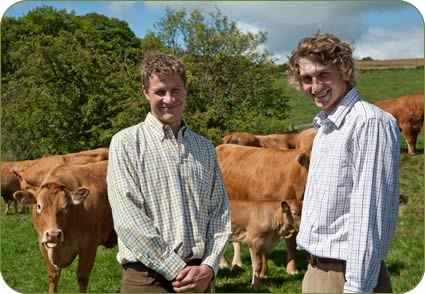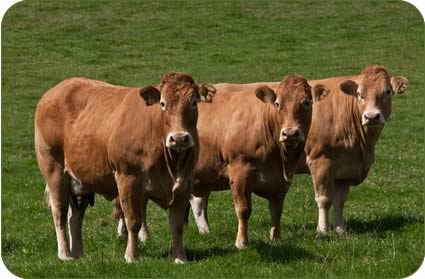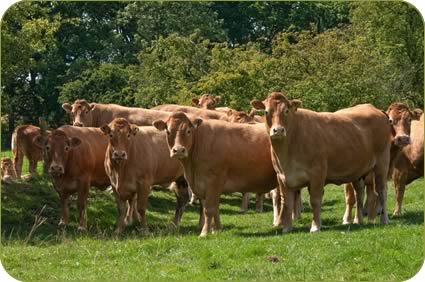Jennifer MacKenzie is an agricultural photo journalist with almost 30 year's experience. Operating from her base in Cumbria, Jennifer undertakes mainly industry-related freelance writing and photography.
New Automatic Heat Detection System
Speeding up genetic progress through AI and embryo transfer in the quest
to improve the pedigree Limousin herd has been greatly assisted by a new
automatic heat detection system on a County Durham farm.
Karl Suddes has taken on the running of the beef enterprise at South Farm,
Cornsay, since he left college and keen to see the herd progress he has
recently introduced AI on the cows in the 100-cow herd.
With only casual labour, time is at a premium for Karl and his brother
Richard and parents Rob and Janis on their 800 acre unit, of which 500
acres are arable and run alongside a total of 300 head of cattle. The mainly
winter-sown crops are barley mainly for home use and wheat and oil seed
rape which are sold.
 |
| Richard Suddes, left, and brother Karl |
Up until 2001 the family, who has farmed at Cornsay since the 1800s, milked
100 dairy cows. The cows had run with the Limousin bull for many years,
producing beefy, easy to sell finished progeny, so the breed was the natural
choice for establishing a pedigree beef herd when re-stocking.
After a trip to France, 120 maiden and in-calf heifers were imported from
12 farms by Rob and his brother Jim.
Various stock bulls have been used, including French imported sires with
the latest new bloodline through a Neuf son, Australien, which is putting
its mark on the herd with shape, length and height.
This gave the herd a solid base but the family saw an opportunity to build
the Cornsay herd more aggressively with AI and embryo work.
With this in mind, Karl completed an AI course in May 2010. “On the
course we were advised to watch the cows for 20 minutes several times a
day which was virtually impossible for me because of our workload,” said
Karl.
To help him with heat detection Karl tried using heat mounting detector
pads on the cows but came across difficulties. “They were unreliable
and there was no way I would have used expensive semen based on this system,” said
Karl.
“The cows were popping all the time - we’re not sure how. It
could have been the calves - but the patch would turn red and within a
few days the new pad would be red again.
“But I appreciated how important it is to pick up heats accurately
and this is why I started to do research into automatic heat detection
systems.
 |
| Pedigree Limousin females |
“Our cows are housed in October-November time and the majority of
the cows calve from October to March inside with a few in May and June.
I also wanted to do the AI work when they were inside so a heat detection
system could be used easily.
“One of the main initial attractions to the NMR Silent Herdsman system
was that the whole of our cattle housing which can have 120-plus animals
was covered by the signal from one antenna which has a 40 metre range,
rather than buying several scanners to locate around the buildings.”
Last year 40 cows were served by AI after the purchase of the system. “We
put the collars straight onto the cows as they calved and started using
the system.”
The robust collars have a high performance processor that monitors motion
behavious. Any changes from the cow’s standard routine are picked
up and transmitted through the base antennae, which is on a beam in the
shed, to the touch screen PC monitor.
This is happening 24/7. The PC will provide an action list of cows that
have come into heat and ensures that no data is lost. “I check the
screen for heats four ties a day and AI morning and the evening - timing
is everything,” he adds. “There are very few bulling cows that
go unnoticed,” said Karl.
Rob feeds the cattle silage, with the inclusion of straw depending on cow
condition, once a day in the morning through a complete diet feeder and
while the cows are eating they are locked into headlocks in the feed barrier
so that those in heat can be served with no stress or hassle. Cows that
are observed bulling during the day can be served in the evening. This
provides extra backup to the system.
Karl will scan the cows this winter but he is confident that at least three
quarters are in calf - having been picked up mainly through the system.
Most were served in January and February and in the following two months
while the cows were still indoors the system continued to monitor them
and picked up minimal heats which is a good sign that most were pregnant.
 |
| Pedigree Limousin females |
Among the crop of calves to be born this autumn will be progeny of Mas
du Clo, Wilodge Cerberus, Rocky and Virginia Andy.
Karl has taken his breeding programme a step further, having flushed one
of the herd’s best imported cows, a five year old bought from a dispersal
sale last year, with semen from top ranking French bred bull Objat.
“The key to embryo transfers is accurate heat detection which is
exactly what the system does,” said Karl.
“As well as using AI for natural births, I also plan to carry out
more embryo transplant work as it is a quick way to gain genetic improvement
in the herd. Using these methods we have much better control over breeding
and can select a sire which complements each cow and improves it,” he
added.
Stock bulls are used to sweep up after two services and for use on the
later calving cows and the heifers. With more of the herd now being home-bred,
Karl is aiming to tighten up the calving pattern, and fertility will be
an important trait.
Bulls from the herd are primarily aimed at the commercial beef producer
to produce a shapey, well-grown calf. So far the herd’s top priced
bull has been Cornsay Demetrius which sold at the February 2010 society
sale in Carlisle to a County Durham suckler herd for 4,000gns.
Females have been sold with the top price being for a heifer at 3,800gns
for Cornsay Vertex at a heifer production sale in Carlisle in 2006 to a
breeder in Orkney.
Herd health is paramount with the cattle in the SAC premium health scheme
since 2007, testing for Johnes, IBR and BVD. The herd has been Johnes accredited
since 2009 and is routinely vaccinated against BVD.

